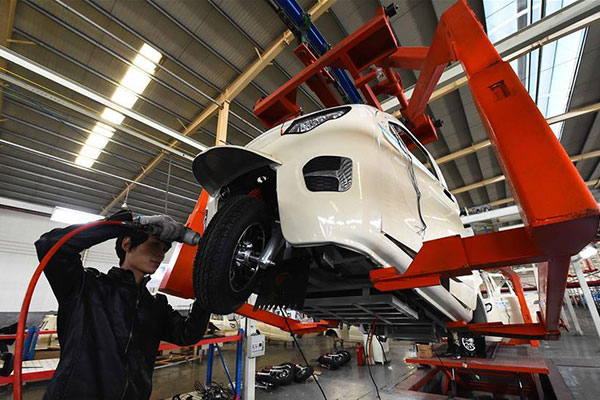
A staff worker works at the assembly line of an electric car manufacturer at Weifang city, East China’s Shandong province, Oct 31, 2017.[Photo/Xinhua]
BEIJING — China is on a steady track to meet its 2017 growth target despite some short-term fluctuations as the government focuses on quality over speed in its pursuit of economic growth.
After a strong performance in the first three quarters, data released by the National Bureau of Statistics (NBS) showed growth of factory output, investment and consumption in October all slowed a notch from the previous month.
Industrial value-added output expanded 6.2 percent year on year in October, slowing from 6.6-percent growth in September. Retail sales of consumer goods grew 10 percent, down from 10.3 percent in September.
In the January-October period, fixed-asset investment grew 7.3 percent year on year, down 0.2 percentage points from the January-September level.
Zhang Jun, economist with Morgan Stanley Huaxin Securities, said the moderation of the indicators was “a short-term fluctuation due to seasonal factors and base effect, and would not change the trend of a stable economic growth.”
China’s economic performance has been generally stable with improved economic structure and quality growth, and it is totally possible for the economy to maintain a stable and positive trend next year, NBS spokesperson Liu Aihua told a news conference.
China has aimed for annual economic growth of around 6.5 percent for 2017, down from the 6.7-percent pace recorded in 2016.
With traditional growth engines losing steam and old growth patterns leading to issues such as environmental degradation and economic inequality, China is pressing ahead with a new model of quality economic development that draws strength from consumption, the services sector and innovation.
NBS data showed the country’s economic rebalancing and industrial upgrades continued apace, injecting vitality into the economy.
Excess capacity cuts have exceeded targets in the bloated steel and coal sectors, while advanced capacity steadily expanded its share.
Corporate leverage was down. Industrial firms above a designated size saw their combined debt ratio fall 0.6 percentage points year on year to 55.7 percent by the end of September.
High-tech industries and equipment manufacturing saw their output jump 13.4 percent and 11.5 percent year on year, respectively, in the January-October period, outpacing the overall industrial output growth.
Despite the slowdown in the October indicators, employment remained stable. Nearly 12 million new jobs were created in cities during the January-October period, already exceeding the annual target of 11 million.
Citing pressure such as slowing credit growth as China focused on financial stability and deleveraging, and a downturn in the real estate sector, UBS economist Wang Tao expected China’s GDP growth to slow modestly to 6.6 percent in the fourth quarter from 6.8 percent in the third quarter.
“Resilient consumption and a positive net trade contribution should offer some support... and we see macro policies staying largely stable,” said Wang in a report.
Wang said the drive to contain financial risk and supply-side structural reform, including excess capacity reductions and stricter environmental rules, may weigh on growth.
Continued efforts to contain financial leverage and asset bubbles since the second half of 2016 have raised financing costs in the real economy, which may erode profit margins of the corporate sector.
Policy makers should balance the competing aims of short-term, credit-fueled growth and long-term policy measures to increase the resilience of the financial system and to reduce and eventually reverse the growth of leverage in the economy, said Zhang Jun.
Premier Li Keqiang said at a symposium last week that China would maintain the stability of its macroeconomic policy, and continue reform and opening up in 2018.
The Premier said China should prioritize quality and efficiency when developing its economy, and deepen supply-side structural reform as well as accelerating cultivation of new growth engines and the transformation of traditional growth drivers.
